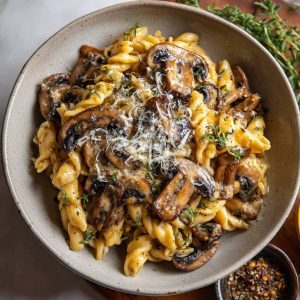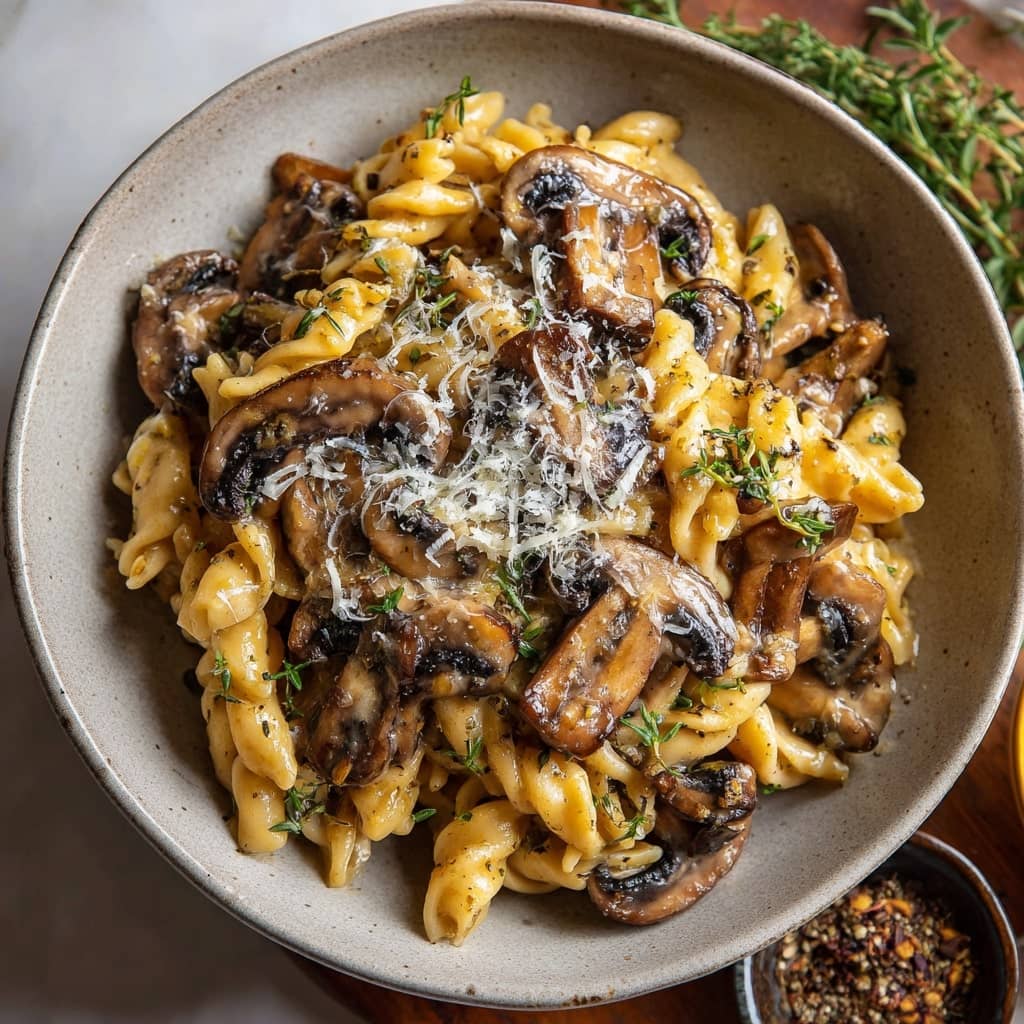Introduction
20-Minute Creamy Mushroom Pasta is the perfect combination of speed, simplicity, and indulgent flavor, offering a rich and satisfying meal that comes together in less time than it takes to order takeout. This dish features tender pasta coated in a luscious, garlic-infused cream sauce loaded with earthy mushrooms and finished with herbs and cheese, creating a luxurious meal that feels fancy but is incredibly easy to make. Whether you’re coming home after a long day, looking for a quick date-night dinner, or just want something cozy and comforting without spending hours in the kitchen, this creamy mushroom pasta delivers big flavor with minimal effort. It’s a weeknight lifesaver and a go-to recipe that proves delicious food doesn’t need to be complicated or time-consuming.
The History of Creamy Mushroom Pasta
While the modern version of creamy mushroom pasta as we know it is often associated with Italian-American cuisine, the concept has roots in traditional European cooking. Mushrooms have long been used in Italian, French, and Eastern European recipes due to their rich umami flavor and abundance in woodland regions. Cream-based sauces gained popularity in northern Italian and French cooking, where dairy was more commonly used. In classic Italian cuisine, pasta dishes featuring mushrooms, such as tagliatelle ai funghi or risotto ai funghi, have been beloved for centuries. The creamy versions began to emerge more prominently in the 20th century with the rise of convenience cooking, especially in the United States and the UK. With the increasing availability of heavy cream and the appeal of quick meals, the fusion of cream, garlic, mushrooms, and pasta became a comforting staple. Over time, the dish evolved into countless variations across kitchens worldwide, becoming a go-to for its balance of ease, richness, and earthy elegance.
Ingredients Breakdown
Pasta: Any type of pasta works well, but fettuccine, linguine, or penne are popular choices for holding onto the creamy sauce.
Mushrooms: Cremini, white button, or baby bella mushrooms are commonly used, but wild mushrooms like shiitake, oyster, or chanterelle elevate the flavor.
Garlic: A key aromatic that brings out the savory depth of the mushrooms and infuses the sauce with flavor.
Olive Oil or Butter: Used to sauté the mushrooms and garlic—olive oil offers a lighter flavor, while butter brings richness.
Heavy Cream: The base of the sauce, providing smooth, velvety texture and richness. You can also use half-and-half or a plant-based cream substitute.
Parmesan Cheese: Adds nutty, salty depth to the sauce and helps it thicken slightly. Freshly grated is best for maximum flavor.
Salt and Pepper: Essential for seasoning; mushrooms need salt to bring out their umami.
Herbs: Fresh parsley or thyme adds brightness and color, while optional red pepper flakes can bring a hint of heat.
Pasta Water: Reserved cooking water helps loosen the sauce and binds it to the pasta thanks to the starch content.
Step-by-Step Recipe
- Bring a large pot of salted water to a boil and cook your pasta according to the package instructions until al dente. Reserve about ½ cup of pasta water before draining.
- While the pasta is cooking, heat olive oil or butter in a large skillet over medium-high heat.
- Add sliced mushrooms and sauté for 5–7 minutes until they release their moisture and become golden brown.
- Stir in minced garlic and cook for another 30–60 seconds until fragrant.
- Lower the heat slightly, then pour in the heavy cream. Simmer gently for 2–3 minutes to thicken slightly.
- Add the grated Parmesan cheese and stir until melted and incorporated into the sauce.
- Season with salt and freshly ground black pepper to taste. Add a splash of reserved pasta water if the sauce is too thick.
- Toss the cooked pasta into the sauce, mixing well to coat each piece. Let it sit on low heat for a minute so the sauce clings to the pasta.
- Serve immediately, topped with fresh parsley or thyme, additional cheese, and a crack of black pepper.
Tips for the Perfect Dish
Use a mix of mushrooms for a deeper, more complex flavor profile—combining cremini with shiitake or oyster mushrooms can take the dish to the next level. Make sure to sauté the mushrooms properly without crowding the pan, which ensures they brown rather than steam. Always salt the mushrooms during cooking to enhance their flavor. Use freshly grated Parmesan, not pre-shredded, which often contains anti-caking agents that prevent it from melting smoothly. Don’t rush the cream simmer—allowing it to reduce slightly enhances the sauce’s body and richness. Save pasta water; its starch helps emulsify the sauce and ensures it coats the pasta evenly. Taste the sauce before adding salt, as Parmesan is already salty. Add herbs right before serving to keep their flavor fresh and vibrant.
Variations and Customizations
Make it vegan: Use plant-based butter, coconut cream or oat cream, and nutritional yeast instead of cheese.
Add protein: Toss in cooked chicken, bacon, pancetta, or shrimp for extra substance.
Boost the veggies: Add baby spinach, peas, sun-dried tomatoes, or roasted red peppers for color and nutrition.
Go low-carb: Use zucchini noodles, spaghetti squash, or shirataki noodles as a pasta alternative.
Make it extra cheesy: Add a handful of mozzarella, fontina, or Gruyère for extra gooey texture.
Swap the cream: Try crème fraîche, mascarpone, or even a bit of Greek yogurt (stirred in off the heat) for a tangy twist.
Add wine: Deglaze the pan with white wine after sautéing the mushrooms for added depth and complexity.
Spice it up: Add red pepper flakes or a dash of cayenne for a little heat.
Health Considerations and Nutritional Value
Creamy mushroom pasta is a rich, comforting dish that can be made more balanced with a few simple modifications. Mushrooms themselves are low in calories and high in fiber, antioxidants, and B vitamins like riboflavin and niacin, which support energy metabolism and brain health. To lighten the dish, opt for whole grain pasta or legume-based pasta for added fiber and protein. Using half-and-half instead of heavy cream, or even plant-based cream, can reduce saturated fat without sacrificing creaminess. Adding vegetables like spinach, kale, or peas boosts vitamin content and creates a more rounded meal. For those watching sodium, go easy on added salt and choose low-sodium Parmesan or omit it entirely. A moderate portion of creamy mushroom pasta can fit into a healthy diet, especially when paired with a fresh salad or roasted vegetables.
FAQ
Can I use milk instead of cream? Yes, but the sauce will be thinner—try adding a bit of flour or cornstarch to thicken it if needed.
What type of pasta is best for this dish? Fettuccine, linguine, and penne all work well, but any shape you enjoy will do.
Can I make this ahead of time? It’s best served fresh, but you can make the sauce in advance and reheat gently before tossing with cooked pasta.
How do I reheat leftovers? Gently warm on the stove or in the microwave with a splash of milk or pasta water to loosen the sauce.
Can I freeze creamy mushroom pasta? Not recommended, as the cream sauce may separate when thawed and reheated.
How do I make it gluten-free? Use your favorite gluten-free pasta and ensure other ingredients, like stock or cheese, are certified gluten-free.
Is it possible to add more vegetables? Absolutely—spinach, kale, zucchini, or peas make great additions.
Can I add meat to the dish? Yes, cooked chicken, bacon, sausage, or shrimp pair wonderfully with the creamy sauce.
Does it work without cheese? You can skip Parmesan and add nutritional yeast for a dairy-free alternative with a cheesy flavor.
Can I use canned mushrooms? Fresh is highly recommended for flavor and texture, but canned mushrooms can be used in a pinch—just drain them well.

20-Minute Creamy Mushroom Pasta
Ingredients
- 4 servings of your preferred pasta cooked al dente
- 2 cups of mushrooms of your choice thinly sliced
- 2 shallots finely chopped
- 3 tablespoons butter
- 1½ tablespoons soy sauce
- 1 teaspoon dashi powder
- ½ teaspoon black pepper
- 1 cup cream or milk
- Garnish for 4 servings:
- Chopped chives
- Grated Parmesan cheese
Instructions
- Cook the pasta according to the package instructions until al dente, then drain and set it aside.
- Place the sliced mushrooms in a large skillet over medium-high heat and sauté them dry (without oil) for 2–3 minutes to enhance their natural aroma.
- Add 2 tablespoons of butter, the soy sauce, and chopped shallots to the pan. Continue to sauté for another 2–3 minutes until the shallots become soft and translucent.
- Stir in the cream or milk, black pepper, and dashi powder. Mix everything thoroughly and taste to check if additional salt is needed.
- Bring the mixture to a gentle simmer for about 2 minutes, then add the cooked pasta to the pan. Toss everything together and cook over high heat for 1–2 minutes, allowing the pasta to absorb the sauce.
- Finish by adding the remaining tablespoon of butter and freshly chopped chives. Top with grated Parmesan cheese for an extra creamy and flavorful finish.
Notes
For the mushrooms, I’m using a mix of shiitake, cremini, and shimeji mushrooms. You can use any variety you like, but I highly recommend including shiitake mushrooms if possible—they bring a deep, savory umami flavor that really sets this dish apart.
If you’re VEGETARIAN, simply swap out the dashi powder for miso paste for a similar depth of flavor without using fish-based ingredients.

